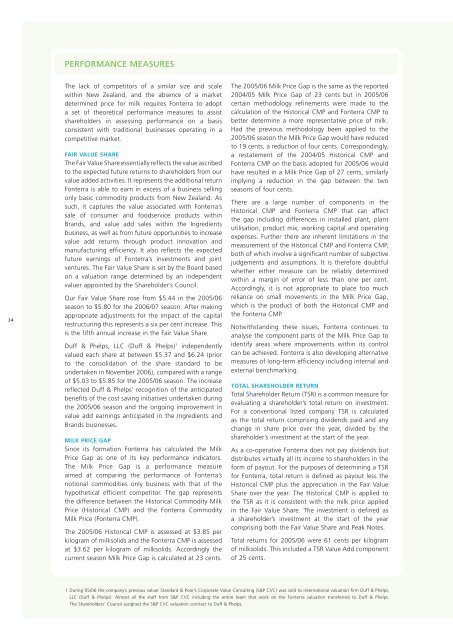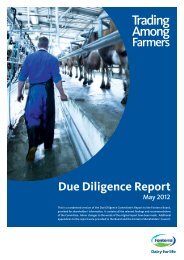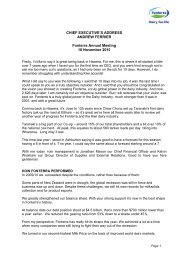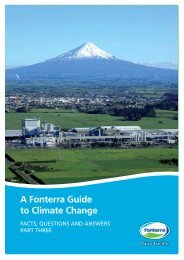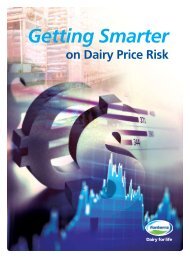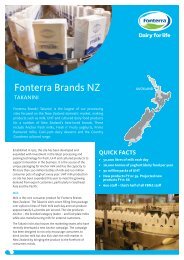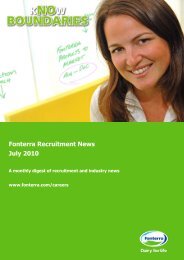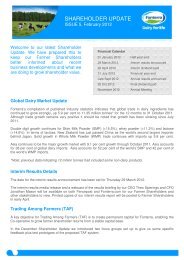F o n t e r r a
F o n t e r r a
F o n t e r r a
Create successful ePaper yourself
Turn your PDF publications into a flip-book with our unique Google optimized e-Paper software.
PERFORMANCE MEASURES34The lack of competitors of a similar size and scalewithin New Zealand, and the absence of a marketdetermined price for milk requires Fonterra to adopta set of theoretical performance measures to assistshareholders in assessing performance on a basisconsistent with traditional businesses operating in acompetitive market.FAIR VALUE SHAREThe Fair Value Share essentially reflects the value ascribedto the expected future returns to shareholders from ourvalue added activities. It represents the additional returnFonterra is able to earn in excess of a business sellingonly basic commodity products from New Zealand. Assuch, it captures the value associated with Fonterra’ssale of consumer and foodservice products withinBrands, and value add sales within the Ingredientsbusiness, as well as from future opportunities to increasevalue add returns through product innovation andmanufacturing efficiency. It also reflects the expectedfuture earnings of Fonterra’s investments and jointventures. The Fair Value Share is set by the Board basedon a valuation range determined by an independentvaluer appointed by the Shareholder’s Council.Our Fair Value Share rose from $5.44 in the 2005/06season to $5.80 for the 2006/07 season. After makingappropriate adjustments for the impact of the capitalrestructuring this represents a six per cent increase. Thisis the fifth annual increase in the Fair Value Share.Duff & Phelps, LLC (Duff & Phelps) 1 independentlyvalued each share at between $5.37 and $6.24 (priorto the consolidation of the share standard to beundertaken in November 2006), compared with a rangeof $5.03 to $5.85 for the 2005/06 season. The increasereflected Duff & Phelps’ recognition of the anticipatedbenefits of the cost saving initiatives undertaken duringthe 2005/06 season and the ongoing improvement invalue add earnings anticipated in the Ingredients andBrands businesses.MILK PRICE GAPSince its formation Fonterra has calculated the MilkPrice Gap as one of its key performance indicators.The Milk Price Gap is a performance measureaimed at comparing the performance of Fonterra’snotional commodities only business with that of thehypothetical efficient competitor. The gap representsthe difference between the Historical Commodity MilkPrice (Historical CMP) and the Fonterra CommodityMilk Price (Fonterra CMP).The 2005/06 Historical CMP is assessed at $3.85 perkilogram of milksolids and the Fonterra CMP is assessedat $3.62 per kilogram of milksolids. Accordingly thecurrent season Milk Price Gap is calculated at 23 cents.The 2005/06 Milk Price Gap is the same as the reported2004/05 Milk Price Gap of 23 cents but in 2005/06certain methodology refinements were made to thecalculation of the Historical CMP and Fonterra CMP tobetter determine a more representative price of milk.Had the previous methodology been applied to the2005/06 season the Milk Price Gap would have reducedto 19 cents, a reduction of four cents. Correspondingly,a restatement of the 2004/05 Historical CMP andFonterra CMP on the basis adopted for 2005/06 wouldhave resulted in a Milk Price Gap of 27 cents, similarlyimplying a reduction in the gap between the twoseasons of four cents.There are a large number of components in theHistorical CMP and Fonterra CMP that can affectthe gap including differences in installed plant, plantutilisation, product mix, working capital and operatingexpenses. Further there are inherent limitations in themeasurement of the Historical CMP and Fonterra CMP,both of which involve a significant number of subjectivejudgements and assumptions. It is therefore doubtfulwhether either measure can be reliably determinedwithin a margin of error of less than one per cent.Accordingly, it is not appropriate to place too muchreliance on small movements in the Milk Price Gap,which is the product of both the Historical CMP andthe Fonterra CMP.Notwithstanding these issues, Fonterra continues toanalyse the component parts of the Milk Price Gap toidentify areas where improvements within its controlcan be achieved. Fonterra is also developing alternativemeasures of long-term efficiency including internal andexternal benchmarking.TOTAL SHAREHOLDER RETURNTotal Shareholder Return (TSR) is a common measure forevaluating a shareholder’s total return on investment.For a conventional listed company TSR is calculatedas the total return comprising dividends paid and anychange in share price over the year, divided by theshareholder’s investment at the start of the year.As a co-operative Fonterra does not pay dividends butdistributes virtually all its income to shareholders in theform of payout. For the purposes of determining a TSRfor Fonterra, total return is defined as payout less theHistorical CMP plus the appreciation in the Fair ValueShare over the year. The Historical CMP is applied tothe TSR as it is consistent with the milk price appliedin the Fair Value Share. The investment is defined asa shareholder’s investment at the start of the yearcomprising both the Fair Value Share and Peak Notes.Total returns for 2005/06 were 61 cents per kilogramof milksolids. This included a TSR Value Add componentof 25 cents.1 During 05/06 the company’s previous valuer Standard & Poor’s Corporate Value Consulting (S&P CVC) was sold to international valuation firm Duff & Phelps,LLC (Duff & Phelps). Almost all the staff from S&P CVC including the entire team that work on the Fonterra valuation transferred to Duff & Phelps.The Shareholders’ Council assigned the S&P CVC valuation contract to Duff & Phelps.


